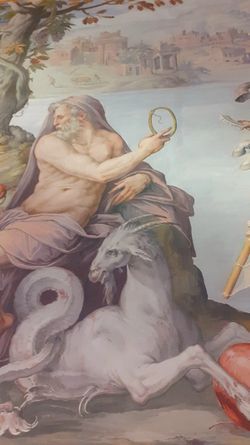From Bioblast
Oroboros logo
The original "Ouroboros"
- The original "Ouroboros" is from:
- Abraham Eleazar (1760) Uraltes chymisches Werk. 2nd ed, Leipzig.
- The dragon forming a cycle, feeding on its own tail: In mitochondrial physiology this is autophagy. In alchemy, the Oroboros is an emblem of the eternal, cyclic nature of the universe, combining idea and action, efficiency and power. The Oroboros is grasping the whole by the conception of the opposite, the divine process of creation and the evil backlash of destruction. In thermodynamics, the alchemist's search for the eternal Unity has been continued in the many efforts to construct a machine operating at 100% efficiency, the Perpetuum Mobile. 100% efficiency is the prerequisite for a truly cyclic nature of energy flux through the biosphere. The notion of the arrow of time, introduced by the Second Law of thermodynamics, replaces the quest for 100% efficiency by the pursuit of a balanced management of the resources of energy and time. Such optimization of efficient material recycling and balanced resource utilization is a vital responsibility of modern society for the protection of local and global ecological systems.
- The Oroboros is one of the rare universal examples where feeding on external negative entropy, deS/dt, is not true, as shown by the feedback loop and the system boundaries. In terms of ergodynamics, at any rate, Oroboros is the fine state of non-thermodynamic equilibrium.
The ancient symbol that spanned millennia
- As a new exhibition looks at the concept of the loop, Joobin Bekhrad discovers how one symbol had different meanings in ancient Egypt, Hindu mythology and Renaissance alchemy: http://www.bbc.com/culture/story/20171204-the-ancient-symbol-that-spanned-millennia
Archetypical symbol
- In alchemy, the “Oroboros” (the tail-eater) is the symbol for the repetition of the transformation process which, through heating, vaporization, cooling and condensation leads to the purification of the material and releases its essence – by a cyclical return and unification of opposites. In its form of a snake, the Oroboros symbolises the physical cycle and, as a dragon, the winged fantasies of metaphysical projections on reality. Creation and the created become one in an inseparable process within the continuing cycle of the Oroboros.
- The fundamental theme of singularity and reproducibility moves Richard Agreiter’s work into the magnetic field between the poles of art and science – and this parallels the leitmotif of the MiPArt Gallery. MiPArt attempts to make scientific concepts more comprehensible through art and, at the same time, to bring the art closer to its scientific background – an exciting cooperation between science and art, between artist and scientist. MiPArt derives from the term “mitochondrial physiology” – MiP (www.mitophysiology.org). Mitochondrial physiology is the most important field of application for the instrument, the Oroboros O2k, developed by Oroboros Instruments in collaboration with WGT Elektronik (Philipp Gradl, Kolsass) and Lukas Gradl (software security networks, Innsbruck). The O2k is the research tool at the centre of the work done by Erich Gnaiger and his team at the Medical University of Innsbruck, and is distributed by Oroboros Instruments to research laboratories throughout the world. In line with this global perspective, the MiPArt Gallery wishes to open doors for its artists by providing access to an international network.
- Since 18th April 2008, the archetypal mythical creature Oroboros, magnified by the creative force of Harald Kirchebner’s artistic impetus, frames the entrance to the MiPArt Gallery, known since then as “Oroboros house”.
- And so is formed a symbol, visible to the wider world, of the model which has shaped the countless scientific co-operations and methodological developments by Erich Gnaiger and his many partners over the last 25 years and which has now become an invitation to visit MiPArt.
- Source: Erich Gnaiger and Richard Agreiter (2009) RICHARD AGREITER - The Mystery of the Serial Form. Singularity – Reproducibility – Validity. Semantic Changes in Art and Science. English translation by Eileen Harrison. Oroboros MiPArt Publications 2010: page 50.
- References
|









